Answered step by step
Verified Expert Solution
Question
1 Approved Answer
Need help with this very large extra credit assignment!!!!! It would be greatly appreciated and I will leave a like!!! TYPE ANSWER HERE 3. What
Need help with this very large extra credit assignment!!!!! It would be greatly appreciated and I will leave a like!!! 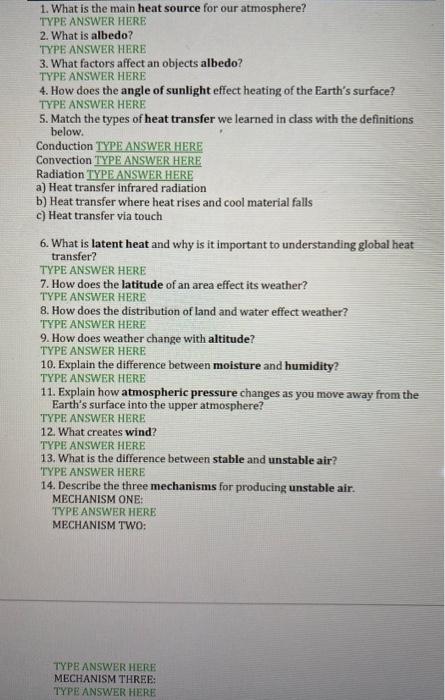
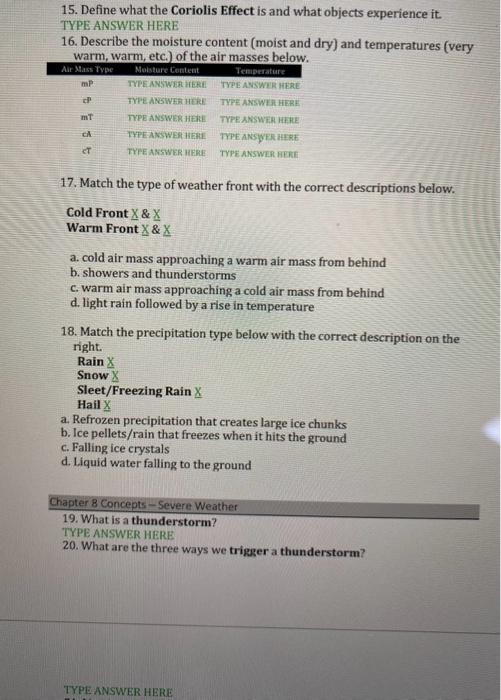
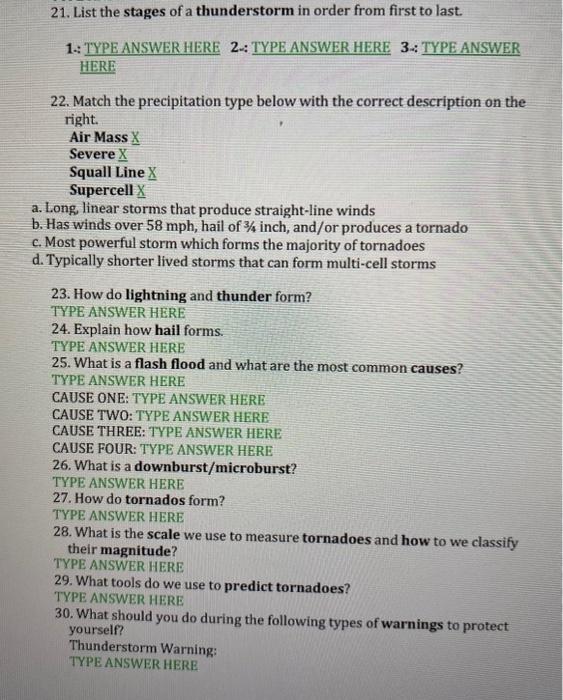
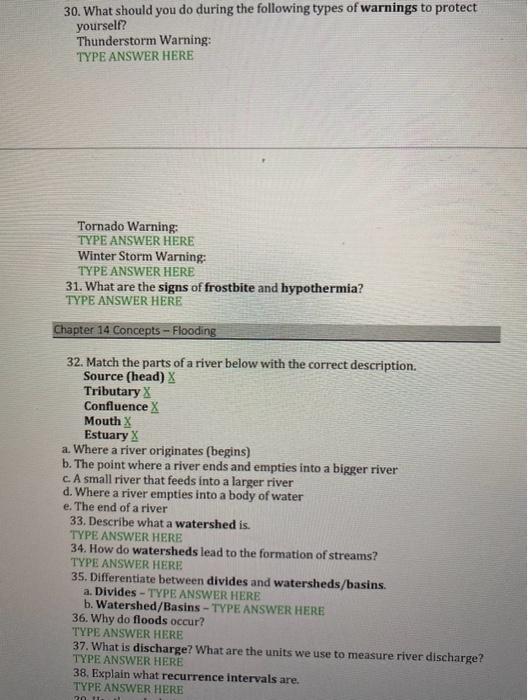
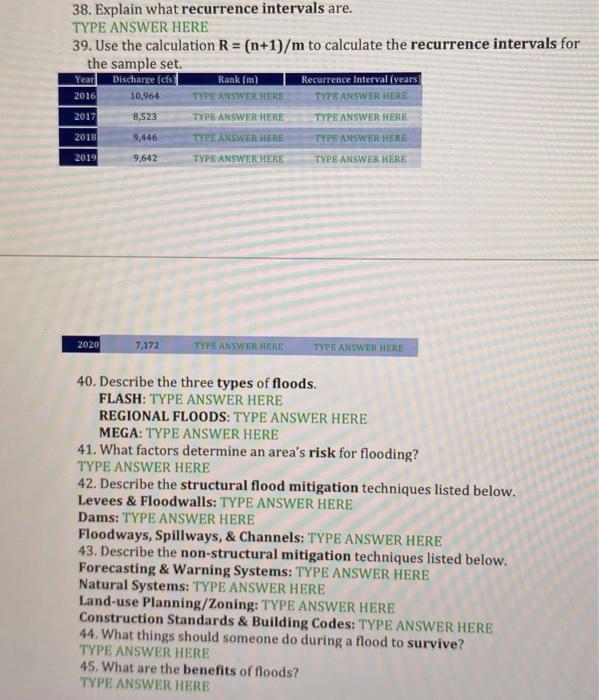
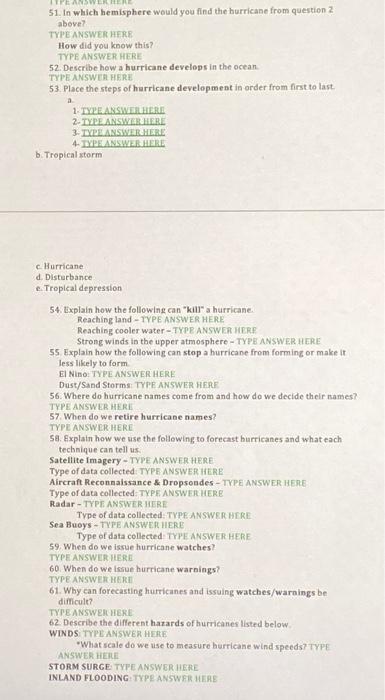
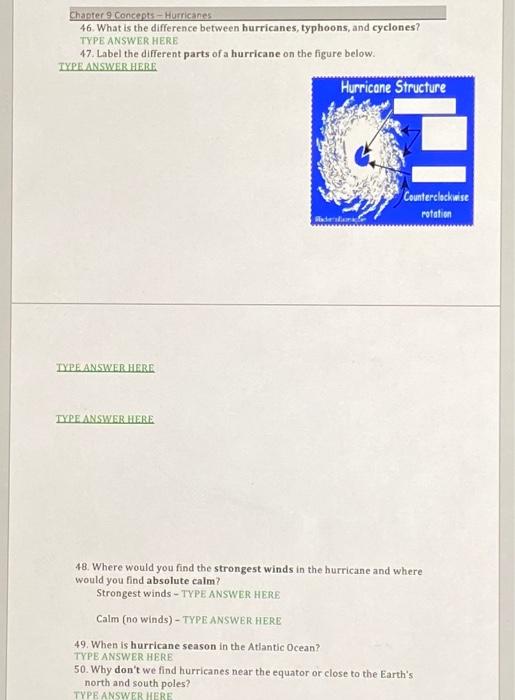
TYPE ANSWER HERE 3. What factors affect an objects albedo? TYPE ANSWER HERE 4. How does the angle of sunlight effect heating of the Earth's surface? TYPE ANSWER HERE 5. Match the types of heat transfer we learned in class with the definitions below. Conduction TYPE ANSWER HERE Convection TYPE ANSWFR HERE Radiation TYPE. ANSWER HERE a) Heat transfer infrared radiation b) Heat transfer where heat rises and cool material falls c) Heat transfer via touch 6. What is latent heat and why is it important to understanding global heat transfer? TYPE ANSWER HERE 7. How does the latitude of an area effect its weather? TYPE ANSWER HERE 8. How does the distribution of land and water effect weather? TYPE ANSWER HERE 9. How does weather change with altitude? TYPE ANSWER HERE 10. Explain the difference between moisture and humidity? TYPE ANSWER HERE 11. Explain how atmospheric pressure changes as you move away from the Earth's surface into the upper atmosphere? TYPE ANSWER HERE 12. What creates wind? TYPE ANSWER HERE 13. What is the difference between stable and unstable air? TYPE ANSWER HERE 14. Describe the three mechanisms for producing unstable air. MECHANISM ONE: TYPB ANSWER HERE MECHANISM TWO: 15. Define what the Coriolis Effect is and what objects experience it TYPE ANSWER HERE 16. Describe the moisture content (moist and dry) and temperatures (very warm, warm, etc.) of the air masses below. 17. Match the type of weather front with the correct descriptions below. Cold Front X&X Warm Front X&X a. cold air mass approaching a warm air mass from behind b. showers and thunderstorms c. warm air mass approaching a cold air mass from behind d. light rain followed by a rise in temperature 18. Match the precipitation type below with the correct description on the right. Rain X Snow Sleet/Freezing Rain x Hail X a. Refrozen precipitation that creates large ice chunks b. Ice pellets/rain that freezes when it hits the ground c. Falling ice crystals d. Liquid water falling to the ground Chapter 8 Concepts - Severe Weather 19. What is a thunderstorm? TYPE ANSWER HERE 20. What are the three ways we trigger a thunderstorm? 21. List the stages of a thunderstorm in order from first to last. 1: TYPE ANSWER HERE 2:: TYPE ANSWER HERE 3-: TYPE ANSWER HERE 22. Match the precipitation type below with the correct description on the right. Air Mass X Severe X Squall Line X Supercell X a. Long, linear storms that produce straight-line winds b. Has winds over 58mph, hail of 3/4 inch, and/or produces a tornado c. Most powerful storm which forms the majority of tornadoes d. Typically shorter lived storms that can form multi-cell storms 23. How do lightning and thunder form? TYPE ANSWER HERE 24. Explain how hail forms. TYPE ANSWER HERE 25. What is a flash flood and what are the most common causes? TYPE ANSWER HERE CAUSE ONE: TYPE ANSWER HERE CAUSE TWO: TYPE ANSWER HERE CAUSE THREE: TYPE ANSWER HERE CAUSE FOUR: TYPE ANSWER HERE 26. What is a downburst/microburst? TYPE ANSWER HERE 27. How do tornados form? TYPE ANSWER HERE 28. What is the scale we use to measure tornadoes and how to we classify their magnitude? TYPE ANSWER HERE 29. What tools do we use to predict tornadoes? TYPE ANSWER HERE 30. What should you do during the following types of warnings to protect yourself? Thunderstorm Warning: TYPE ANSWER HERE 30. What should you do during the following types of warnings to protect yourself? Thunderstorm Warning: TYPE ANSWER HERE Tornado Warning: TYPE ANSWER HERE Winter Storm Warning: TYPE ANSWER HERE 31. What are the signs of frostbite and hypothermia? TYPE ANSWER HERE Chapter 14 Concepts - Flooding 32. Match the parts of a river below with the correct description. Source (head) X Tributary X Confluence X Mouth X Estuary X a. Where a river originates (begins) b. The point where a river ends and empties into a bigger river c. A small river that feeds into a larger river d. Where a river empties into a body of water e. The end of a river 33. Describe what a watershed is. TYPE ANSWER HERE 34. How do watersheds lead to the formation of streams? TYPE ANSWER HERE, 35. Differentiate between divides and watersheds/basins. a. Divides - TYPE ANSWER HERE b. Watershed/Basins - TYPE ANSWER HERE 36. Why do floods occur? TYPE ANSWER HERE 37. What is discharge? What are the units we use to measure river discharge? TYPE ANSWER HERE 38. Explain what recurrence intervals are. TYPE ANSWER HERE 38. Explain what recurrence intervals are. TYPE ANSWER HERE 39. Use the calculation R=(n+1)/m to calculate the recurrence intervals for the sample set. 2020 7,172 TYPE ANSWTR HERE TYPE ANSWER HLRE 40. Describe the three types of floods. FLASH: TYPE ANSWER HERE REGIONAL FLOODS: TYPE ANSWER HERE MEGA: TYPE ANSWER HERE 41. What factors determine an area's risk for flooding? TYPE ANSWER HERE 42. Describe the structural flood mitigation techniques listed below. Levees \& Floodwalls: TYPE ANSWER HERE Dams: TYPE ANSWER HERE Floodways, Spillways, & Channels: TYPE ANSWER HERE 43. Describe the non-structural mitigation techniques listed below. Forecasting \& Warning Systems: TYPE ANSWER HERE Natural Systems: TYPE ANSWER HERE Land-use Planning/Zoning: TYPE ANSWER HERE Construction Standards \& Building Codes: TYPE ANSWER HERE 44. What things should someone do during a flood to survive? TYPE ANSWER HERE 45. What are the benefits of foods? TYPE ANSWER HERE 51. In which hemisphere would you find the hurricane from question 2 . above? TYPE ANSWER HFRE How did you know this? TYPE ANSWER HERE 52. Describe how a hurricane develops in the ocean TYPE-ANSWIB HERE 53. Place the steps of harricane development in order from first to last a 1. TYZE ANSWEH HERII 2. TYPE ANSWER HIRE: 3. TYPL ANSWER HERE 4 - TYEANSWER HERE b. Tropical xtorm C. Hurricane d. Disterbance. c. Tropical depression 54. txplain how the following can "kill" a hurricane. Reaching land - TYPE ANSWER HERE Reaching cooler water-TYPE ANSWER IIPRF Strong winds is the upper atmosphere - TYPB ANSWER HERE 55. Explain how the following can stop a hurricane from forming or make it less likely to form EI NIBO: TYPE ANSWER HERE Dast/Sand Storms TYPE. ANSWER HERF 56. Where do hurricane names come from and how do we decide their names? TYPE ANSWER HERL 57. When do we retire hurricane names? TYPE ANSWER HERE 58. Explain how we use the following to forecast burricanes and what each techaique can tell us. Satellite Imagery - TYPE A NSWER HERE Type of data collected. TYPE ANSWER HERE Aircraft Reconnaissance \& Dropsendes - TVPE ANSWER HERE Type of data collected-TYPE ANSWER HERE Radar - TYPE ANSWER HERE Type of data collected:TYPEA ASWER HFRE Sea Bueys - TYPE ANSWTH HERE Type of data collected TYPE ANSWER HERE 59. When do we issue hurricane watches? TYPEANSWLR HERE 60. When do we issue hurricane warnings? TYPE ANSWE HERI 61. Why can forecasting hurricanes and issuing watches/warnings be dificule? TYPEANSWEICHERE 62. Describe the different harards of hurricanes listed below WINDS TYPE ANSWER HERE "What scale do we use to measure burricane wind speeds? TYPE ANSWER HEME STORM SURGE TYPE ANSWER HERE INLAND FLOODING TYPE ANSWFR URRE Chapter 9 Concepts - Hurricanes 46. What is the difference between hurricanes, typhoons, and cyclones? TYPE ANSWER HERE 47. Label the different parts of a hurricane on the figure below: IYPE ANSWER HERE TYPE. ANSWER HERE TYPE ANSWER HERE 48. Where would you find the strongest winds in the hurricane and where would you find absolute calm? Strongest winds - TYPE ANSWER HERE Calm (no winds) - TYPE ANSWER HERE 49. When is hurricane season in the Atlantic Ocean? TYPE ANSWER HERE 50. Why don't we find hurricanes near the equator or close to the Earth's north and south poles 






Step by Step Solution
There are 3 Steps involved in it
Step: 1

Get Instant Access to Expert-Tailored Solutions
See step-by-step solutions with expert insights and AI powered tools for academic success
Step: 2

Step: 3

Ace Your Homework with AI
Get the answers you need in no time with our AI-driven, step-by-step assistance
Get Started


